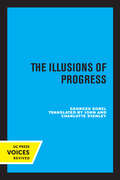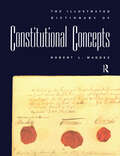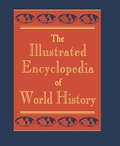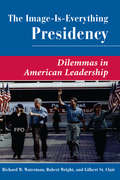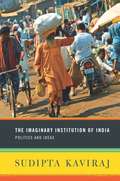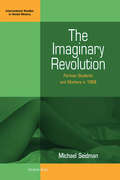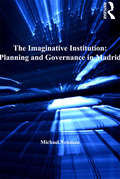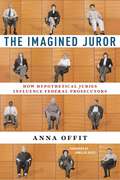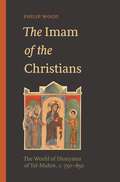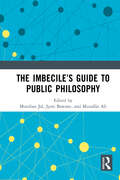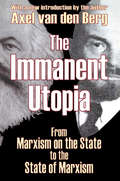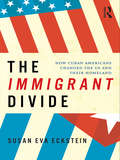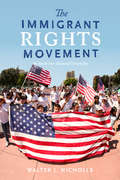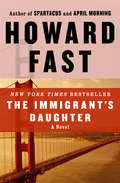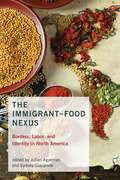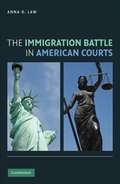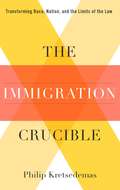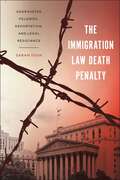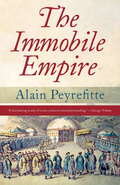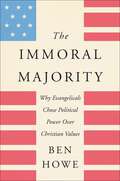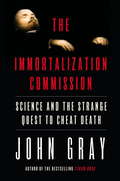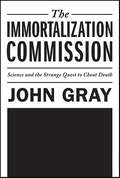- Table View
- List View
The Illusions Of Egalitarianism
by John KekesIn this systematic and scathing attack on the dominant contemporary version of liberalism, John Kekes challenges political assumptions shared by the majority of people in Western societies. Egalitarianism, as it's widely known, holds that a government ought to treat all citizens with equal consideration. Kekes charges that belief in egalitarianism rests on illusions that prevent people from facing unpleasant truths. <p><p> Kekes, a major voice in modern political thought, argues that differences among human beings in the areas of morality, reasonability, legality, and citizenship are too important for governance to ignore. In a rigorous criticism of prominent egalitarian thinkers, including Dworkin, Nagel, Nussbaum, Rawls, Raz, and Singer, Kekes charges that their views present a serious threat to both morality and reason. <p> For Kekes, certain "inegalitarian truths" are obvious: people should get what they deserve, those who are good and those who are evil should not be treated as if they had the same moral worth, people should not be denied what they have earned in order to benefit those who have not earned it, and individuals should be held responsible for their actions. His provocative book will compel many readers to question their faith in liberalism.
The Illusions of Progress
by Georges SorelThis title is part of UC Press's Voices Revived program, which commemorates University of California Press’s mission to seek out and cultivate the brightest minds and give them voice, reach, and impact. Drawing on a backlist dating to 1893, Voices Revived makes high-quality, peer-reviewed scholarship accessible once again using print-on-demand technology. This title was originally published in 1969.
The Illusory Bargain: Liberty in the Aftermath of the 17th Amendment
by Ralph H. LehmanOut-of-control debt. Populism. Political vitriol and corruption. Where did America go wrong? Or rather, when did America go wrong? 1913. The Seventeenth Amendment is ratified, allowing the people of America to vote directly for their senators in the US senate. The same year, the Federal Reserve Act is passed, establishing a central bank to oversee monetary policy. In The Illusory Bargain, Ralph H. Lehman demonstrates that these seemingly empowering and people-serving pieces of legislature were just that-an illusion. Tracing the vision of the Founding Fathers as outlined in The Federalist Papers, Lehman reveals how the safety features of the original constitutional framework have eroded since and given way to rampant abuse of power and arbitrary, tyrannical law. Through fresh, historically informed insights and over twenty years of financial expertise, Lehman reexamines the nation's fundamental values and proposes what may be the only course of action left to restore our liberty.
The Illustrated Dictionary of Constitutional Concepts
by Robert L. MaddexProviding definitions and historical background for more than three hundred key concepts and words, The Illustrated Dictionary of Constitutional Concepts is the first comprehensive reference to terms used around the world. The book also shows, with excerpts, how these concepts and terms are implemented in their respective constitutions.This timely resource also provides biographical profiles of some fifty people - philosophers as well as national leaders - whose ideas and actions have helped form constitutions worldwide. The Illustrated Dictionary of Constitutional Concepts is lavishly illustrated with over 280 blacka and white photos and illustrations of various concepts, people and places throughout the world. The volume include explanations of words and terms that appear in constitutions or are reflected in the structure of governments, from the ancient Greeks to the present day. Each term is placed in its historical perspectiveand, where relevant, its etymology is given. To illustrate how they are used, appropriate excerpts from current national constitutions are provided at the end of each entry.
The Illustrated Encyclopedia of World History
by Donker Van HeelPeter deLeon argues that while it is often individuals who actually engage in political corruption, it is the US political system that condones or encourages such actions. Once this perspective is recognised, one can begin to understand ways in which the costs of corruption might be alleviated.
The Image Is Everything Presidency: Dilemmas In American Leadership
by Gilbert St. ClairImage is everything. Today, our television and movie stars, our athletes, and our politicians carefully craft images for public consumption. Even our country's Executive Chief is not immune to a bit of image manipulation. If presidents can not always actually satisfy the public's excessive, contradictory, and unrealistic expectations, they can at least present a compelling image of presidential leadership and success. When it comes to the modern presidency, tennis star Andre Agassi was correct, ?Image is everything.?Image creation is a serious business with critically important implications for the success of any politician. But presidents must be careful in deciding how they craft the ways in which we perceive them. If they are to succeed, presidents must present an appropriate image of leadership to the American people; an image that is appropriate for the particular needs of the time when the president governs and is appropriate to the personality of that president. Their ultimate goal is to convince the public that they are actually providing leadership, even if in reality they have only a limited ability to effect outcomes.This book examines the way American presidents in the media age have shaped their public personas as a means of cultivating and advancing their political and ideological agendas. Images play an important role in the perceived success or failure of our presidents. Since public expectations are most often aimed directly at the White House and its central occupant, it is more important than ever that a president control his image, as well as presenting the right image to the American public. Reality thus becomes secondary and image is everything.
The Imaginary Institution of India: Politics and Ideas
by Sudipta KavirajFor decades Sudipta Kaviraj has worked with and improved upon Marxist and subaltern studies, capturing India's social and political life through its diverse history and culture. While this technique has been widely celebrated in his home country, Kaviraj's essays have remained largely scattered abroad. This collection finally presents his work in one convenient volume and, in doing so, reasserts the brilliance of his approach.As evidenced in these essays, Kaviraj's exceptional strategy positions Indian politics within the political philosophy of the West and alongside the perspectives of Indian history and indigenous political thought. Studies include the peculiar nature of Indian democracy; the specific aspects of Jawaharlal Nehru's and Indira Gandhi's regimes; political culture in independent India; the construction of colonial power; the relationship between state, society, and discourse; the structure of nationalist discourse; language and identity formation in Indian contexts; the link between development and democracy, or democratic functioning; and the interaction among religion, politics, and modernity in South Asia. Each of these essays explores the place of politics in the social life of modern India and is powered by the idea that Indian politics is plastic, reflecting and shaping the world in which people live.
The Imaginary Revolution
by Michael SeidmanThe events of 1968 have been seen as a decisive turning point in the Western world. The author takes a critical look at "May 1968" and questions whether the events were in fact as "revolutionary" as French and foreign commentators have indicated. He concludes the student movement changed little that had not already been challenged and altered in the late fifties and early sixties. The workers' strikes led to fewer working hours and higher wages, but these reforms reflected the secular demands of the French labor movement. "May 1968" was remarkable not because of the actual transformations it wrought but rather by virtue of the revolutionary power that much of the media and most scholars have attributed to it and which turned it into a symbol of a youthful, renewed, and freer society in France and beyond.
The Imaginative Institution: Planning And Governance In Madrid
by Michael NeumanEvery 20 years since 1920, Madrid has undergone an urban planning cycle in which a city plan was prepared, adopted by law, and implemented by a new institution. This preparation-adoption-institutionalization sequence, along with the institution's structures and procedures, have persisted - with some exceptions - despite frequent upheavals in society. The planning institution itself played a lead role in maintaining continuity, traumatic history notwithstanding. Why and how was this the case? Madrid's planners, who had mostly trained as architects, invented new images for the city and metro region: images of urban space that were social constructs, the products of planning processes. These images were tools that coordinated planning and urban policy. In a complex, fragmented institutional milieu in which scores of organized interests competed in overlapping policy arenas, images were a cohesive force around which plans, policies, and investments were shaped. Planners in Madrid also used their images to build new institutions. Images began as city or metropolitan designs or as a metaphor capturing a new vision. New political regimes injected their principles and beliefs into the governing institution via images and metaphors. These images went a long way in constituting the new institution, and in helping realize each regime's goals. This empirically-based life cycle theory of institutional evolution suggests that the constitutional image sustaining the institution undergoes a change or is replaced by a new image, leading to a new or reformed institution. A life cycle typology of institutional transformation is formulated with four variables: type of change, stimulus for change, type of constitutional image, and outcome of the transformation. By linking the life cycle hypothesis with cognitive theories of image formation, and then situating their synthesis within a frame of cognition as a means of structuring the institution, this book arrives at a new theory
The Imagined Juror: How Hypothetical Juries Influence Federal Prosecutors
by Annelise Riles Anna OffitExamines the outsized influence of jurors on prosecutorial discretion Thanks to television and popular media, the jury is deeply embedded in the American public’s imagination of the legal system. For the country’s federal prosecutors, however, jurors have become an increasingly rare sight. Today, in fact, less than 2% of their cases will proceed to an actual jury trial. And yet, when federal prosecutors describe their jobs and what the profession means to them, the jury is a central theme. Anna Offit’s The Imagined Juror examines the counterintuitive importance of jurors in federal prosecutors’ work at a moment when jury trials are statistically in decline. Drawing on extensive field research among federal prosecutors, the book represents “the first ethnographic study of US attorneys,” according to legal scholar Annelise Riles. It describes a world of legal practice in which jurors are frequently summoned—as make-believe audiences for proposed arguments, hypothetical evaluators of evidence, and invented decision-makers who would work together to reach a verdict. Even the question of moving forward with a prosecution often hinges on how federal prosecutors assume a jury will react to elements of the case—an exercise where the perspectives of the public are imagined and incorporated into every stage of trial preparation.Based on these findings, Offit argues that the decreasing number of jury trials at the federal level has not eliminated the influence of the jury but altered it. As imaginary figures, jurors continue to play an important and understudied role in shaping the work and professional identities of federal prosecutors. At the same time, imaginary jurors are not real jurors, and prosecutors at times caricature the public by leaning on stereotypes or preconceived and simplistic ideas about how laypeople think. Imagined jurors, it turns out, are a critical, if flawed, resource for introducing lay perspective into the legal process. As Offit shows, recentering laypeople and achieving the democratic promise of our legal system will require renewed commitment to the jury trial and juries that reflect the diversity of the American public.
The Imagined, the Imaginary and the Symbolic
by Maurice GodelierExploring the close relationship between the real and the symbolic and imaginaryWhat you imagined is not always imaginary, but everything that is imaginary is imagined. It is by imagining that people make the impossible become possible. In mythology or religion, however, those things that are imagined are never experienced as being imaginary by believers. The realm of the imagined is even more real than the real; it is super-real, surreal.Lévi-Strauss held that "the real, the symbolic and the imaginary" are three separate orders. Maurice Godelier demonstrates the contrary: that the real is not separate from the symbolic and the imaginary. For instance, for a portion of humanity, rituals and sacred objects and places attest to the reality and therefore the truth that God, gods or spirits exist. The symbolic enables people to signify what they think and do, encompassing thought, spilling over into the whole body, but also pervading temples, palaces, tools, foods, mountains, the sea, the sky and the earth. It is real.Godelier's book goes to the strategic heart of the social sciences, for to examine the nature and role of the imaginary and the symbolic is also to attempt to account for the basic components of all societies and ultimately of human existence. And these aspects in turn shape our social and personal identity.
The Imam of the Christians: The World of Dionysius of Tel-Mahre, c. 750–850
by Philip WoodHow Christian leaders adapted the governmental practices and political thought of their Muslim rulers in the Abbasid caliphateThe Imam of the Christians examines how Christian leaders adopted and adapted the political practices and ideas of their Muslim rulers between 750 and 850 in the Abbasid caliphate in the Jazira (modern eastern Turkey and northern Syria). Focusing on the writings of Dionysius of Tel-Mahre, the patriarch of the Jacobite church, Philip Wood describes how this encounter produced an Islamicate Christianity that differed from the Christianities of Byzantium and western Europe in far more than just theology. In doing so, Wood opens a new window on the world of early Islam and Muslims’ interactions with other religious communities.Wood shows how Dionysius and other Christian clerics, by forging close ties with Muslim elites, were able to command greater power over their coreligionists, such as the right to issue canons regulating the lives of lay people, gather tithes, and use state troops to arrest opponents. In his writings, Dionysius advertises his ease in the courts of ʿAbd Allah ibn Tahir in Raqqa and the caliph al-Ma’mun in Baghdad, presenting himself as an effective advocate for the interests of his fellow Christians because of his knowledge of Arabic and his ability to redeploy Islamic ideas to his own advantage. Strikingly, Dionysius even claims that, like al-Ma’mun, he is an imam since he leads his people in prayer and rules them by popular consent.A wide-ranging examination of Middle Eastern Christian life during a critical period in the development of Islam, The Imam of the Christians is also a case study of the surprising workings of cultural and religious adaptation.
The Imbecile’s Guide to Public Philosophy
by Murzban JalThis book studies the role of serious philosophizing in everyday life and looks at how authoritarianism negates philosophical and public reason. It sheds light on how philosophy can go beyond its life as a discipline limited to an esoteric group of academia to manifest itself via radical discursive practices in public life which enable us to understand and resolve contemporary socio-political challenges. It studies philosophy as a discipline which deals with one's orientations based on experience, the logic of reasoning, critical thinking, and most of all radical and progressive beliefs. The book argues that the contemporary rise of capitalism in modern society, resonating Émile Durkheim’s cautions on "anomie", has favoured individualism, differentiation, marginalization, and exploitation, balanced on an eroding collective consciousness and a steady disintegration of humanity and reason. Taking this into consideration, it discusses how philosophy, both mainstream and marginal, can revive democracy in society which then is able to confront global authoritarianism led by the figure of the imbecile. Finally, it also provides a range of new perspectives on the questions of civic freedom, hegemony of language, social justice, identity, invisible paradigms, gender justice, democracy, multiculturalism, and decolonization. This book is an invigorating compilation of essays from diverse disciplines, engaging the need to create a humanistic public philosophy to transcend the state of imbecility. It will be of great interest to students, scholars and researchers of philosophy, contemporary politics, history, and sociology, as well as general readers.
The Immanent Utopia: From Marxism on the State to the State of Marxism
by Axel Van den BergThe spectacular growth in the 1970s and 1980s of the Marxist literature on politics and the state in capitalist society was hailed at the time as cumulative proof of Marxism's success in producing an effective theory of the political superstructure. More generally, it was seen as confirmation of the health and vigor of Marxist theory. Axel van den Berg questions both of these claims. Through comprehensive analysis of Marxist thought on bourgeois politics and the state, from that produced by Marx himself on, van den Berg radically challenges the viability of a distinctly Marxist theory of the state and of recent Marxist theorizing in general. In an exhaustive review of the literature, van den Berg shows that neo-Marxist theories are, for the most part, not empirically testable. To the extent that it is possible to draw any empirical implications from these theories at all, such implications are virtually indistinguishable from those of "bourgeois" theories. Van den Berg proceeds to lay bare the contradiction at the heart of Marxist theory in general: it presupposes the viability and desirability of some ideal socialist society yet its "anti-utopian" insistence that all criticisms of capitalism must rest on foundations immanent in capitalism itself prohibits any open discussion of such a utopia. Now available in paperback, this is a fundamental work for political and social theorists."This work is brilliant in its polemical courage, its originality, and its detailed and revealing examination of texts. Van den Berg demonstrates that postwar Marxist political theory and sociology is not only vague and contradictory but that it actually makes critical concessions to the bourgeois thought' it claims to surpass. Appearing in the midst of afar-reaching reconsideration of the Marxism project in Europe, this volume crystallizes these issues for North American social science..."--Jeffrey Alexander, University of California, Los Angeles."Van den Berg has made a major contribution to the long overdue relegation of Marxism to the museum of nineteenth-century ideological antiquities."--Dennis Wrong, Contemporary Sociology.Axel van den Berg is a Dutch-Canadian professor of sociology at McGill University in Montreal. His most recent work is The Social Sciences and Rationality.
The Immigrant Divide: How Cuban Americans Changed the U.S. and Their Homeland
by Susan EcksteinAre all immigrants from the same home country best understood as a homogeneous group of foreign-born? Or do they differ in their adaptation and transnational ties depending on when they emigrated and with what lived experiences? Between Castro’s rise to power in 1959 and the early twenty-first century more than a million Cubans immigrated to the United States. While it is widely known that Cuban émigrés have exerted a strong hold on Washington policy toward their homeland, Eckstein uncovers a fascinating paradox: the recent arrivals, although poor and politically weak, have done more to transform their homeland than the influential and prosperous early exiles who have tried for half a century to bring the Castro regime to heel. The impact of the so-called New Cubans is an unintended consequence of the personal ties they maintain with family in Cuba, ties the first arrivals oppose. This historically-grounded, nuanced book offers a rare in-depth analysis of Cuban immigrants’ social, cultural, economic, and political adaptation, their transformation of Miami into the "northern most Latin American city," and their cross-border engagement and homeland impact. Eckstein accordingly provides new insight into the lives of Cuban immigrants, into Cuba in the post Soviet era, and into how Washington’s failed Cuba policy might be improved. She also posits a new theory to deepen the understanding not merely of Cuban but of other immigrant group adaptation.
The Immigrant Rights Movement: The Battle over National Citizenship
by Walter J. NichollsIn the months leading up to the 2016 presidential election, liberal outcry over ethnonationalist views promoted a vision of America as a nation of immigrants. Given the pervasiveness of this rhetoric, it can be easy to overlook the fact that the immigrant rights movement began in the US relatively recently. This book tells the story of its grassroots origins, through its meteoric rise to the national stage. Starting in the 1990s, the immigrant rights movement slowly cohered over the demand for comprehensive federal reform of immigration policy. Activists called for a new framework of citizenship, arguing that immigrants deserved legal status based on their strong affiliation with American values. During the Obama administration, leaders were granted unprecedented political access and millions of dollars in support. The national spotlight, however, came with unforeseen pressures—growing inequalities between factions and restrictions on challenging mainstream views. Such tradeoffs eventually shattered the united front. The Immigrant Rights Movement tells the story of a vibrant movement to change the meaning of national citizenship, that ultimately became enmeshed in the system that it sought to transform.
The Immigrant's Daughter: A Novel (The Lavette Legacy #2)
by Howard FastThe fifth installment of Fast&’s bestselling Immigrants series, continuing the story of one of his most beloved characters, Barbara Lavette. Howard Fast&’s immensely popular Immigrants saga spanned six novels and more than a century of the Lavette family history. The series was considered one of the crowning achievements of his long career. This New York Times bestseller is the fifth entry in the series and focuses on one of his most beloved characters, Barbara Lavette, whom Fast based on his first wife. At sixty, Barbara is living a quiet life in San Francisco, grieving after the death of a longtime male friend. However, her spirits revive when she mounts an unexpectedly competitive congressional campaign. After narrowly losing the election, Barbara begins to reconnect with her past as a journalist and human rights activist, two passions that reignite the spark of adventure in her life. This ebook features an illustrated biography of Howard Fast including rare photos from the author&’s estate.
The Immigrant-Food Nexus: Borders, Labor, and Identity in North America (Food, Health, and the Environment)
by Julian Agyeman Sydney GiacaloneThe intersection of food and immigration in North America, from the macroscale of national policy to the microscale of immigrants' lived, daily foodways.This volume considers the intersection of food and immigration at both the macroscale of national policy and the microscale of immigrant foodways—the intimate, daily performances of identity, culture, and community through food. Taken together, the chapters—which range from an account of the militarization of the agricultural borderlands of Yuma, Arizona, to a case study of Food Policy Council in Vancouver, Canada—demonstrate not only that we cannot talk about immigration without talking about food but also that we cannot talk about food without talking about immigration.The book investigates these questions through the construct of the immigrant-food nexus, which encompasses the constantly shifting relationships of food systems, immigration policy, and immigrant foodways. The contributors, many of whom are members of the immigrant communities they study, write from a range of disciplines. Three guiding themes organize the chapters: borders—cultural, physical, and geopolitical; labor, connecting agribusiness and immigrant lived experience; and identity narratives and politics, from “local food” to “dietary acculturation.”ContributorsJulian Agyeman, Alison Hope Alkon, FernandoJ. Bosco, Kimberley Curtis, Katherine Dentzman, Colin Dring, Sydney Giacalone, Sarah D. Huang, Maryam Khojasteh, Jillian Linton, Pascale Joassart-Marcelli, Samuel C. H. Mindes, Laura-Anne Minkoff-Zern, Christopher Neubert, Fabiola Ortiz Valdez, Victoria Ostenso, Catarina Passidomo, Mary Beth Schmid, Sea Sloat, Kat Vang, Hannah Wittman, Sarah Wood
The Immigration Battle in American Courts
by Anna O. LawThis book assesses the role of the federal judiciary in immigration and the institutional evolution of the U.S. Supreme Court and of the U.S. Courts of Appeals.
The Immigration Crucible: Transforming Race, Nation, and the Limits of the Law
by Philip KretsedemasIn the debate over U. S. immigration, all sides now support policy and practice that expand the parameters of enforcement. Philip Kretsedemas examines this development from several different perspectives, exploring recent trends in U.S. immigration policy, the rise in extralegal state power over the course of the twentieth century, and discourses on race, nation, and cultural difference that have influenced politics and academia. He also analyzes the recent expansion of local immigration law and explains how forms of extralegal discretionary authority have become more prevalent in federal immigration policy, making the dispersion of local immigration laws possible. While connecting such extralegal state powers to a free flow position on immigration, Kretsedemas also observes how these same discretionary powers have been used historically to control racial minority populations, particularly African Americans under Jim Crow. This kind of discretionary authority often appeals to "states rights" arguments, recently revived by immigration control advocates. Using these and other examples, Kretsedemas explains how both sides of the immigration debate have converged on the issue of enforcement and how, despite differing interests, each faction has shaped the commonsense assumptions defining the debate.
The Immigration Law Death Penalty: Aggravated Felonies, Deportation, and Legal Resistance
by Sarah ToshTraces the role of the aggravated felony in today’s deportation regimeIn immigration courts across America, a non-citizen convicted of an “aggravated felony” will almost certainly face deportation with no access to asylum. However, despite the ominous-sounding name, aggravated felonies need not be either “aggravated” or “felonies.” The term encompasses more than thirty offenses, ranging from check fraud and shoplifting to filing a false tax return. The recent expansion in the list of such offenses has resulted in astronomical rates of deportation.This book chronicles the rise of the use of the aggravated felony, known by lawyers as the “immigration law death penalty,” to criminalize and then deport immigrants. Immigrants convicted of aggravated felonies are subject to mandatory detention and almost certain deportation—and are ineligible for almost all forms of legal relief from removal. Furthermore, immigrants convicted of aggravated felonies can be detained for months or even years without bond, are not guaranteed lawyers, and can even be deported without an opportunity to plead their case in court. Sarah Tosh provides the first in-depth understanding of how aggravated felonies have been used to deport thousands of documented and undocumented immigrants and how the severe, expansive, and racially disparate outcomes have been met with innovative legal responses, bolstered by networks of community-based resistance. The Immigration Law Death Penalty is an urgent read for anyone committed to protecting the rights of immigrants nationwide.
The Immobile Empire
by Alain PeyrefitteIn 1793, Lord George Macartney and an enormous delegation--including diplomats, doctors, scholars, painters, musicians, soldiers, and aristocrats--entered Beijing on a mission to open China to British trade. But Macartney's famous refusal to perform the traditional kowtow before the Chinese Emperor was just one sign that the two empires would not see eye to eye, and the trade talks failed. The inability to develop a trade relation would have enormous consequences for future relations between China and the West. Peyrefitte's vivid narrative of this fascinating encounter is based on extraordinary source materials from each side--including the charming and candid diary of Thomas Staunton, the son of one of Macartney's aides. An example of history at its finest, The Immobile Empire recaptures the extraordinary experience of two great empires in collision, sizing each other up for the first time.
The Immoral Majority: Why Evangelicals Chose Political Power Over Christian Values
by Ben HoweAn analysis of why and how the Religious Right could vote for Donald Trump in 2016, and how the movement can redeem itself and get back on track.In 2016, writer and filmmaker Ben Howe found himself disillusioned with the religious movement he’d always called home. In the pursuit of electoral victory, many American evangelicals embraced moral relativism and toxic partisanship.In The Immoral Majority, Howe—still a believer and still deeply conservative—analyzes and debunks the intellectual dishonesty and manipulative rhetoric that evangelical leaders use to convince Christians to toe the Republican Party line. He covers the history of the Christian Right, as well as the events of the last three decades that led to the current state of the conservative movement at large.As long as evangelicals prioritize power over persuasion, Howe argues, their pews will be empty and their national influence will dwindle. If evangelicals hope to avoid cultural irrelevance, it means valuing the eternal over the ephemeral, humility over ego, and resisting the seduction of political power, no matter the cost. The Immoral Majority demonstrates how the Religious Right is choosing the profits of this world at the cost of its soul—and why it’s not too late to change course.
The Immortalization Commission
by John GrayA great philosopher will change the way you think about your life.For most of human history, religion provided a clear explanation of life and death. But in the late 19th and early 20th centuries new ideas -- from psychiatry to evolution to Communist -- seemed to suggest that our fate was now in our own hands. We would ourselves become God.This is the theme of a remarkable new book by one of the world's greatest lving philosophers. It is a brilliant and frightening look at the problems and opportunities of a world coming to grips with humankind's now solitary, unaided place in the universe. Gray takes two major examples: the belief that the science-backed Communism of the new USSR could reshape the planet, and the belief among a group of Edwardian intellectuals -- popularized through mediums and automatic writing -- that there was a non-religious form of life after death.Gray presents an extraordinary cast of philosophers, journalists, politicians, charlatans and mass murderers, all of whom felt driven by a specifically scientific and modern world view. He raises a host of fascinating questions about what it means to be human. The implications of Gray's book will haunt its readers for the rest of their lives.From the Hardcover edition.
The Immortalization Commission: Science and the Strange Quest to Cheat Death
by John GrayA Globe and Mail Best Books of the Year 2011 TitleAt the heart of human experience lies an obsession with the nature of death. Religion, for most of history, has provided an explanation for human life and a vision of what comes after it. But in the late nineteenth and early twentieth centuries, such beliefs came under relentless pressure as new ideas—from psychiatry to evolution to communism—seemed to suggest that our fate was now in our own hands: humans could cease to be animals, defeat death, and become immortal.In The Immortalization Commission, the acclaimed political philosopher and critic John Gray takes a brilliant and frightening look at humankind's dangerous striving toward a scientific version of immortality. Probing the parallel faiths of Bolshevik "God-builders," who sought to reshape the planet and psychical researchers, who believed they had evidence of a nonreligious form of life after death, Gray raises fascinating questions about how such beliefs threaten the very nature of what it means to be human. He looks to philosophers, journalists, politicians, charlatans, and mass murderers who all felt driven by a specifically scientific and modern worldview and whose revolt against death resulted in a series of experiments that ravaged whole countries. An urgent examination of Darwin's post-religious legacy, The Immortalization Commission is an important work from "one of Britain's leading public intellectuals" (The Wall Street Journal).

